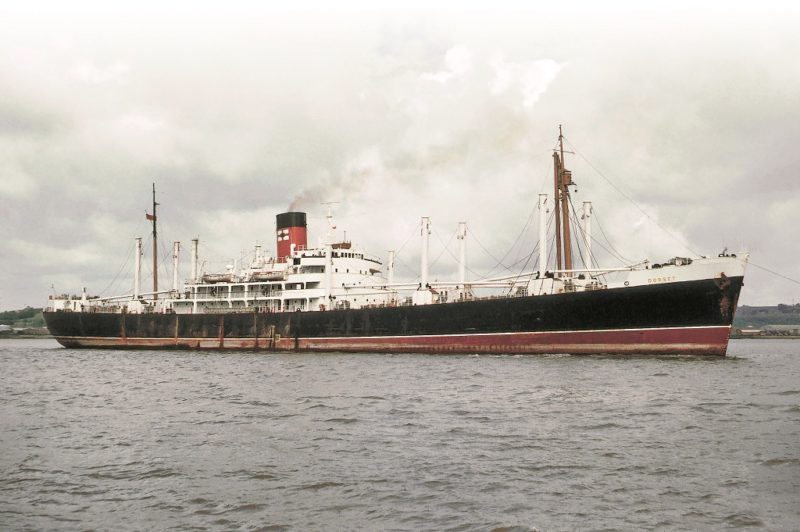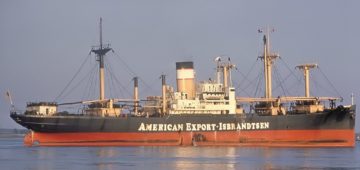
It was now the beginning of January and I had just spent Christmas and New Year at home. I had been informed that the Dorset had finished her coastal voyage, and I was required to rejoin her in Liverpool again. With my rail warrant, and all my things packed, I set off for Liverpool. Once onboard, I reported to the chief steward, made my way to my cabin, got changed and reported for duty. Our cargo again was of the general kind, some of it consisted of motor cars in packing cases, usually known as C.K.D (completely knocked down), you name it we carried it.
Again I was on this ship as the steward’s boy. I was still working in the pantry where we served the food and I did the washing up and most of the cleaning in that area. We all signed on, on 3rd January 1969, all 57 of us and I was being paid £27.15.00 per month. We then set sail and left on 15th January from Liverpool, traversing the docks assisted by two tugs into the locks and out into the river.
Once we were at sea, the Walker’s patent log was put to use. This was an age old device, which streams a 65 fathom line astern, at the end of which is a bronze 18 inch long streamlined rotator, with curved fins, so designed that its revolutions, caused by the ships movement forward, through the water, measured the distance travelled.
This was then transferred, and read on a special clock fitted to the ship’s rail. This would then transmit electronically to a similar clock on the bridge. It was as accurate a measure of our progress, and speed through the water as could be attained.
The Captain would always inspect the ship every Sunday morning, including everyone’s cabin to ensure they were kept clean. He would wear white gloves to check for cleanliness and not once was I caught out by him. But in some other cabins, he did get his gloves dirty!
After an uneventful voyage skirting the Caribbean, we were soon looking out to sea trying to spot land, and as if by magic, there it was on the horizon. We were arriving at Willemstad on the island of Curaçao to refuel the ship. We arrived and departed on the same day with no time to go ashore. We were on our way to the Panama Canal. It was only two days before, that I had celebrated my eighteenth birthday, with yet another party in my cabin.
We arrived at Colon at the entrance to the Panama Canal on 29th January. It was to take all day to transit the canal and we waited for our turn. At the start, the massive lock gates were opened to let the Dorset in, stopping the engines, and we gently drifted inside, with the help of two tugs. The gates closed and the water started to cascade into the lock. The ship slowly rose until the deck came level with the top of the lock, we then caught sight of the mules that were to pull us into the second lock. They were huge diesel electric locomotives which ran on a toothed track to assist them in climbing the steep gradients up the side of the next lock. I wonder how many people over the years were conned into saving the left over bread for the mules. Finally we exited the third lock and steamed into Gatun Lake, the largest artificial body of water in the world. Some of us that were still on deck watched as the canal gradually began to narrow and I wondered how many ships had used the canal since the first transit on 15th August 1914. We passed several ships going the other way as we made steady progress. eventually the canal began to widen and we entered the Miraflores lake before we entered the Pedro Miguel locks, again stopping the engines. We finally reached Balboa at the other end of the canal. We disembarked our pilot, what a lovely job he has!

We were soon on our way across the Pacific Ocean, which was to last three weeks.
We arrived at Wellington on 17th February, my first time here. My cousin Michael had been here, when he was on the Tyrone back in 1958. Once we were tied up, unloading commenced. We were there for ten days and I made loads of visits ashore. I had a ride on the Kilburn cable car which went up above the city of Wellington to the botanical gardens. What a fantastic view from here, a view that must be seen by anyone who visits Wellington.
We left there on 27th February for our next port of call, Lyttleton, for unloading. We were to be there for a whole week for more unloading, also to load apples and frozen lamb. These items were brought onto the quay inside railway wagons, and transferred to the ship in big nets.
Again, I made my usual trips ashore. I also made a trip to the neighbouring city of Christchurch and this place reminded me of Cambridge back in England.
We left there on 8th March and made our way back up the coast towards Nelson. We spent nearly another week there loading more apples and frozen lamb for the UK. We left there on 15th March and made our way to the small port of Picton, arriving there othe next day. We left there on 20th March after a lot of fresh apples and frozen lamb was loaded onboard.
This was an unusual voyage to New Zealand as normally more ports were visited for loading, but I understand there just was not enough cargo available to take back home.
I think a lot of this had to with the coming of containerisation which killed off the traditional tramp steamer. We were now on our way home and with a steady plod across the Pacific Ocean, taking another three weeks. With more sunbathing and sleeping on deck we were soon to be nearing the Panama Canal once more. We arrived at Balboa on 6th April. As we arrived there later in the day, most of the voyage through the canal would be at night, arriving at the other end of the canal the next day at the port of Colon. We then made our way towards Willemstad for refuelling, arriving and leaving the same day with no time ashore again. I never did see much of this place!
Then it was off on the way home, crossing the North Atlantic and traversing the English Channel, and up the North Sea to the port of Hull. We arrived there on Monday 21st April. Once tied up, we were able to sign off and when the relief crew came onboard we were able to leave the ship. I made my way to the railway station for the train to London and home.




Comments
Sorry, comments are closed for this item